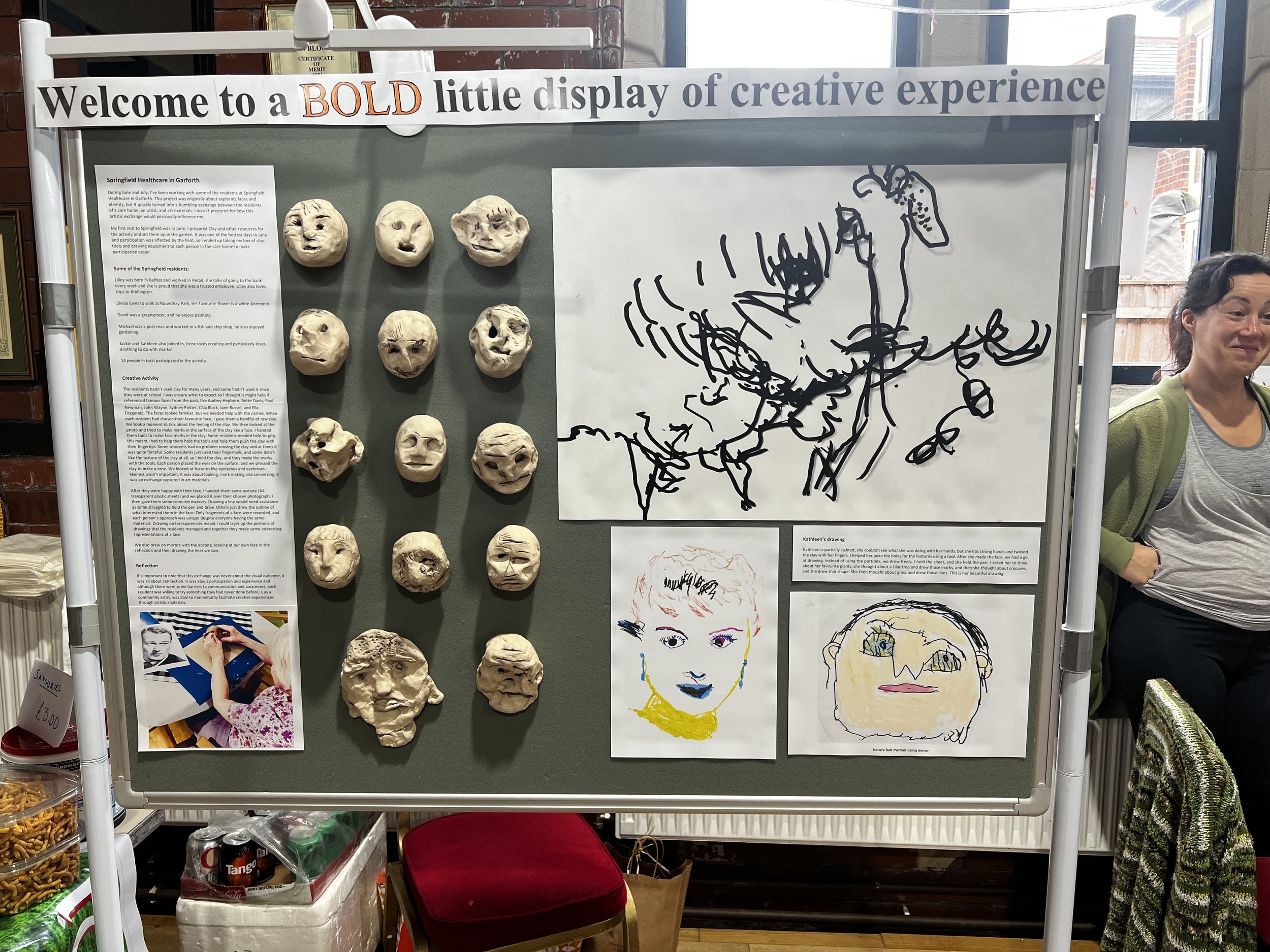Garforth and Swillington Creative Hub - Leeds 2023
Springfield Healthcare in Garforth
During June and July, I’ve been working with some of the residents at Springfield Healthcare in Garforth. This project was originally about exploring faces and identity, but it quickly turned into a humbling exchange between the residents of a care home, an artist, and art materials. I wasn’t prepared for how this artistic exchange would personally influence me.
My first visit to Springfield was in June; I prepared Clay and other resources for the activity and set them up in the garden. It was one of the hottest days in June and participation was affected by the heat, so I ended up taking my box of clay. tools and drawing equipment to each person in the care home to make participation easier.
Some of the Springfield residents:
Lilley was born in Belfast and worked in Retail, she talks of going to the bank every week and she is proud that she was a trusted employee, Lilley also loves trips to Bridlington.
Sheila loves to walk at Roundhay Park, her favourite flower is a white Anemone.
David was a greengrocer, and he enjoys painting.
Michael was a post man and worked in a fish and chip shop, he also enjoyed gardening.
Jackie and Kathleen also joined in, Irene loves creating and particularly loves anything to do with sharks!
14 people in total participated in the activity.
Kathleen’s drawing
Kathleen is partially sighted; she couldn’t see what she was doing with her hands, but she has strong hands and twisted the clay with her fingers. I helped her poke the holes for the features using a tool. After she made the face, we had a go at drawing. Instead of using the portraits, we drew freely. I held the sheet, and she held the pen. I asked her to think about her favourite plants, she thought about a Lilac tree and drew those marks, and then she thought about crocuses, and she drew that shape. She then thought about grass and drew those lines. This is her beautiful drawing.
Creative Activity
The residents hadn’t used clay for many years, and some hadn’t used it since they were at school. I was unsure what to expect so I thought it might help if referenced famous faces from the past, like Audrey Hepburn, Bette Davis, Paul Newman, John Wayne, Sydney Poitier, Cilla Black, Jane Russel, and Ella Fitzgerald. The faces looked familiar, but we needed help with the names. When each resident had chosen their favourite face, I gave them a handful of raw clay. We took a moment to talk about the feeling of the clay. We then looked at the photo and tried to make marks in the surface of the clay like a face. I handed them tools to make face marks in the clay. Some residents needed help to grip, this meant I had to help them hold the tools and help them push the clay with their fingertips. Some residents had no problem moving the clay and at times it was quite forceful. Some residents just used their fingernails, and some didn’t like the texture of the clay at all, so I held the clay, and they made the marks with the tools. Each person placed the eyes on the surface, and we pressed the clay to make a nose. We looked at features like eyelashes and eyebrows - likeness wasn’t important, it was about looking, mark making and conversing, it was an exchange captured in art materials.
I had to scoop out the insides to make each face less than 1cm thick. They would have blown up in the kiln if I had left the lump too thick.
After they were happy with their face, I handed them some acetate (A4 transparent plastic sheets) and we placed it over their chosen photograph. I then gave them some coloured markers. Drawing a line would need assistance as some struggled to hold the pen and draw. Others just drew the outline of what interested them in the face. Only fragments of a face were recorded, and each person’s approach was unique despite everyone having the same materials. Drawing on transparencies meant I could layer up the portions of drawings that the residents managed and together they made some interesting representations of a face.
We also drew on mirrors with the acetate, looking at our own face in the reflection and then drawing the lines we saw.
This is Irene, she is very confident with her drawing, I like her eyelashes.
Reflection
It’s important to note that this exchange was never about the visual outcome, it was all about connection. It was about participation and experience and although there were some barriers to communication and awareness, each resident was willing to try something they had never done before. I, as a community artist, was able to momentarily facilitate creative experiences through artistic materials.
This is the display for the Garforth and Swillington ward Creative Hub for the Leeds 2023.








